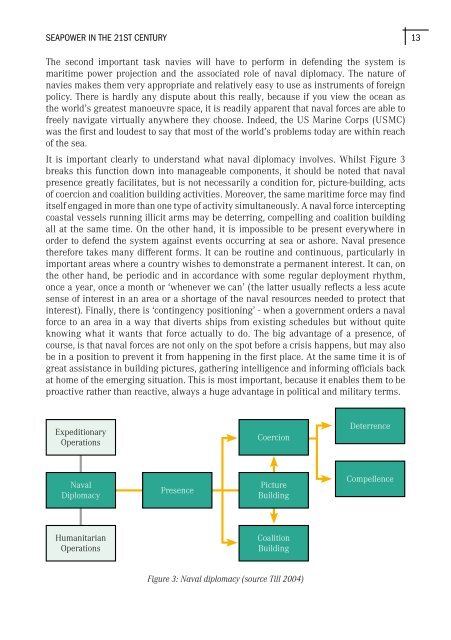Australian Maritime Issues 2005 - Royal Australian Navy
Australian Maritime Issues 2005 - Royal Australian Navy
Australian Maritime Issues 2005 - Royal Australian Navy
You also want an ePaper? Increase the reach of your titles
YUMPU automatically turns print PDFs into web optimized ePapers that Google loves.
SEAPOWER IN THE 21ST CENTURY<br />
13<br />
The second important task navies will have to perform in defending the system is<br />
maritime power projection and the associated role of naval diplomacy. The nature of<br />
navies makes them very appropriate and relatively easy to use as instruments of foreign<br />
policy. There is hardly any dispute about this really, because if you view the ocean as<br />
the world’s greatest manoeuvre space, it is readily apparent that naval forces are able to<br />
freely navigate virtually anywhere they choose. Indeed, the US Marine Corps (USMC)<br />
was the first and loudest to say that most of the world’s problems today are within reach<br />
of the sea.<br />
It is important clearly to understand what naval diplomacy involves. Whilst Figure 3<br />
breaks this function down into manageable components, it should be noted that naval<br />
presence greatly facilitates, but is not necessarily a condition for, picture-building, acts<br />
of coercion and coalition building activities. Moreover, the same maritime force may find<br />
itself engaged in more than one type of activity simultaneously. A naval force intercepting<br />
coastal vessels running illicit arms may be deterring, compelling and coalition building<br />
all at the same time. On the other hand, it is impossible to be present everywhere in<br />
order to defend the system against events occurring at sea or ashore. Naval presence<br />
therefore takes many different forms. It can be routine and continuous, particularly in<br />
important areas where a country wishes to demonstrate a permanent interest. It can, on<br />
the other hand, be periodic and in accordance with some regular deployment rhythm,<br />
once a year, once a month or ‘whenever we can’ (the latter usually reflects a less acute<br />
sense of interest in an area or a shortage of the naval resources needed to protect that<br />
interest). Finally, there is ‘contingency positioning’ - when a government orders a naval<br />
force to an area in a way that diverts ships from existing schedules but without quite<br />
knowing what it wants that force actually to do. The big advantage of a presence, of<br />
course, is that naval forces are not only on the spot before a crisis happens, but may also<br />
be in a position to prevent it from happening in the first place. At the same time it is of<br />
great assistance in building pictures, gathering intelligence and informing officials back<br />
at home of the emerging situation. This is most important, because it enables them to be<br />
proactive rather than reactive, always a huge advantage in political and military terms.<br />
Expeditionary<br />
Operations<br />
Coercion<br />
Deterrence<br />
Naval<br />
Diplomacy<br />
Presence<br />
Picture<br />
Building<br />
Compellence<br />
Humanitarian<br />
Operations<br />
Coalition<br />
Building<br />
Figure 3: Naval diplomacy (source Till 2004)

















